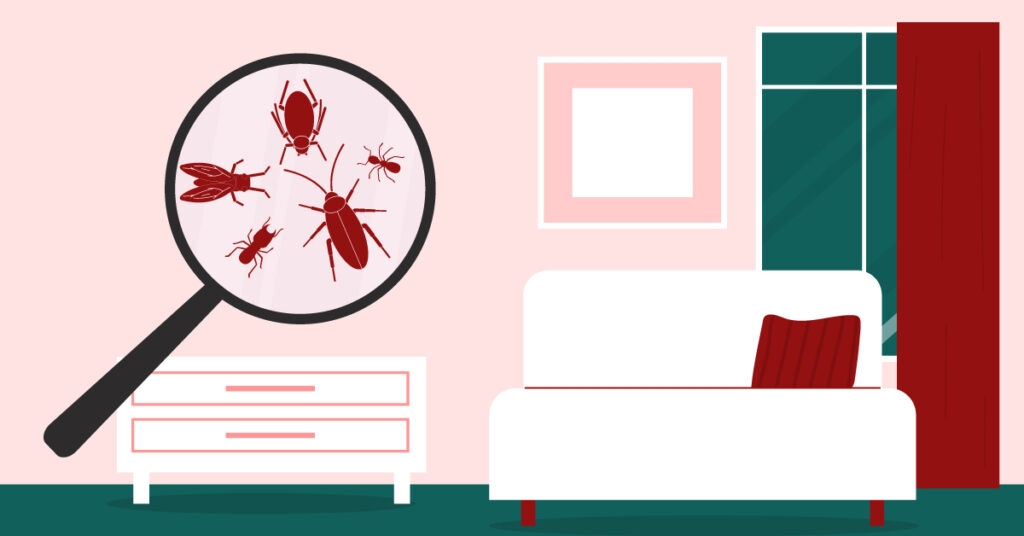Natural pest control relies on the power of beneficial insects to keep garden pests in check. Instead of using chemicals, homeowners can encourage these “good bugs” to hunt or parasitize the “bad bugs,” which results in a healthier, more balanced backyard ecosystem where plants thrive with less damage.
Below, we’ll explain how beneficial insects work, highlight common species, and give practical tips and product suggestions for attracting these tiny garden allies.
Understanding Natural Pest Control with Beneficial Insects
When many gardeners see bugs on their plants, they assume trouble. Yet most insects are not harmful – and some are downright helpful, supporting plant health through pollination and by preying on pests. These beneficial insects act as nature’s pest control squad. Predatory insects, such as lacewings or ladybugs, feed on common garden pests, while parasitoid insects, like certain wasps, lay eggs in pest insects, killing them from within. By welcoming a diversity of insects into your yard, you create a balanced mini-ecosystem where good bugs keep bad bugs under control.
Unlike spraying pesticides (which often kill beneficial bugs along with pests), nurturing natural predators is safe, effective, and sustainable. Don’t expect complete eradication of every pest – the goal is suppression, not elimination. Beneficial insects help reduce pest populations below damaging levels, so your flowers and veggies suffer minimal harm. This method fits perfectly into an Integrated Pest Management (IPM) approach.
In short, by letting bugs fight your battles, you protect your garden naturally while avoiding broad-spectrum pesticides that can backfire by killing allies like ladybugs and ground beetles.
Meet Your Garden Allies: Beneficial Insect Species

Many types of insects are beneficial, but a few stand out as particularly valuable in home gardens. Predators such as ladybugs, lacewings, hoverflies, and ground beetles consume a wide range of pests, while parasitic wasps target specific insect hosts. Below, we highlight some common beneficial insects and how they help:
Ladybugs (Ladybird Beetles)
A ladybug (lady beetle) feasting on a colony of aphids. Ladybug adults and larvae are voracious predators of sap-sucking pests.
Few garden allies are as famous as the ladybug. Also called ladybird beetles, these charming red-and-black beetles are ferocious aphid eaters in both adult and larval form. A single ladybug or its alligator-like larva can consume dozens of aphids, whiteflies, mites, or scale insects per day. In fact, ladybird larvae eat a large volume of pests, including aphids, leafhoppers, mealybugs, scale, spider mites, and whiteflies. Gardeners even use ladybugs in greenhouses to control outbreaks.
To attract ladybugs, grow pollen-rich flowers they love. In addition to pest prey, ladybugs feed on pollen and nectar, so include plants like cosmos, marigold, calendula, yarrow, cilantro, or angelica in your garden. These blooms will draw ladybugs naturally. You can also purchase live ladybugs – nurseries often sell mesh bags of adult lady beetles for home release. When releasing store-bought ladybugs, do so carefully for optimal results. Release them at dusk near infested plants, after lightly watering the foliage, so they have moisture and immediate food (such as aphids) to prevent them from flying off. Providing shallow water dishes (with pebbles for landing) and sheltered spots (such as leaf piles, ground cover, or dense shrubs) will encourage ladybugs to stay. With the right habitat, ladybugs will patrol your plants and naturally eliminate aphids and other soft-bodied pests.
Green Lacewings
Another aphid assassin is the delicate green lacewing. Don’t be fooled by the adults’ gossamer wings – it’s their larvae (often called “aphid lions”) that do the dirty work. A single lacewing larva can consume as many as 200 pests in a week! These larvae are alligator-shaped eating machines that attack aphids, small caterpillars, leafhoppers, mealybugs, thrips, and whiteflies, among others. Gardeners sometimes introduce lacewing eggs to combat aphids, since they are avid consumers of many insect pests. Adult lacewings are pollinators that sip nectar, but they will occasionally snack on pests as well.
To attract lacewings, plant flowers that offer them nectar and pollen. Lacewings favor “composite” or flat-topped flowers such as yarrow, dill, cosmos, goldenrod, black-eyed Susan, coriander, and asters. These blooms serve as beacons for adult lacewings, which seek to lay eggs nearby. Lacewings can also be purchased as eggs or larvae and released in the garden – they are commonly used in greenhouses for pest control. If you want lacewings to stay, tolerate a small number of aphids or other prey on your plants (so the larvae have food) and avoid cleaning up all leaf litter, as adults and pupae overwinter in debris and fallen leaves. Leaving some garden debris or delaying fall cleanup provides a safe harbor for lacewings to overwinter and return in spring.
Parasitic Wasps
A tomato hornworm caterpillar parasitized by braconid wasps – the white structures are cocoons of wasp larvae that developed inside the hornworm, a gruesome but effective natural pest control.
Not all wasps are garden terrors – many tiny wasps are garden saviors in disguise. Parasitic wasps (also called parasitoid wasps) target specific pest insects by laying their eggs on or inside the host. For example, braconid wasps sting and deposit eggs into caterpillars, such as tomato hornworms, or into the eggs of pest insects. The wasp larvae then eat the host insect from within, killing it. If you’ve ever found a hornworm covered in little white cocoons, you’ve witnessed parasitic wasps at work (each cocoon was a wasp larva that devoured the hornworm and is about to emerge). Parasitic wasps are very diverse – most are tiny, non-stinging species that parasitize aphids, beetle larvae, caterpillars, fly larvae, scales, and more. For instance, Trichogramma wasps parasitize the eggs of moths and butterflies, while other wasps target tomato hornworms, cabbage worms, or even whiteflies. They are so effective that gardeners and farmers commonly deploy certain parasitic wasps in greenhouses and fields to control caterpillars, whiteflies, and other pests.
To attract parasitic wasps, focus on providing nectar sources from tiny flowers. Adult parasitoid wasps often have short mouthparts and favor blooms in the carrot (Apiaceae) family – plants like dill, cilantro, fennel, caraway, parsley, and Queen Anne’s lace are magnets for these wasps. They also enjoy composite flowers and herbs. Essentially, planting a few umbels and wildflowers can attract beneficial wasps that seek nectar and host plants. These wasps are very small and not interested in humans (they won’t sting you). Ensure they have a consistent source of nectar and water so they stick around. While you typically wouldn’t buy parasitic wasps for a backyard (except in special cases, like Trichogramma egg cards for caterpillar control), simply creating a wasp-friendly habitat will invite local species to take up the fight. Once established, parasitic wasps can keep pests like hornworms and aphids in check with ruthless efficiency – nature’s own biological warfare in your garden.
Ground Beetles and Soldier Beetles
Not all beetles are bad – in fact, many are voracious predators of garden pests. Ground beetles (family Carabidae) are shiny, long-legged beetles, often black or metallic, that scurry along the soil or under leaf litter at night. Both adult and larval ground beetles are beneficial, as they feed on soil-dwelling and surface pests, including slugs, snails, caterpillars, cutworms, maggots, and thrips. A single ground beetle can eat its body weight in prey daily, including slug eggs and even weed seeds. Gardeners sometimes call them “nocturnal slug hunters,” as they are among the best natural enemies of slugs and cutworms in damp gardens. Ground beetles lay eggs in late summer around the bases of perennial plants, and the larvae overwinter in the soil, emerging in spring to continue their pest patrol.
Soldier beetles are another ally to know. Often yellow-orange or black and resembling fireflies, adult soldier beetles are commonly seen on flowers (feeding on pollen). But their larvae are predatory, living in soil and leaf litter where they hunt soft-bodied pests. Soldier beetle larvae devour aphids, caterpillars (including armyworms), cucumber beetle eggs and larvae, grasshopper eggs, and other soft pests. They’ll also opportunistically eat some beneficial insects or harmless ones (no predator is perfect). Adult soldier beetles help pollinate while searching for nectar, so they serve a dual role.
To attract ground beetles and soldier beetles, provide the habitat they need: dense plant cover and undisturbed soil or mulch. A perennial border or hedgerow is ideal for ground beetles. They also benefit from an active compost pile or mulch layer, which offers food and shelter. Delay heavy garden cleanup until spring, so you don’t disturb overwintering beetle eggs or larvae in fall. For soldier beetles, grow plants that produce nectar and pollen. They enjoy flowers like catnip, goldenrod, marigold, hydrangea, yarrow, zinnias, and Queen Anne’s lace– planting these will bring adult soldier beetles that will lay eggs in your garden soil. By making parts of your yard a little “wild” (leaf litter, mulch, and perennial plantings), you invite these beetle species to take up residence and snack on pests around the clock.
Hoverflies (Syrphid Flies)
Often mistaken for small bees, hoverflies are beneficial two-fold: the adults pollinate flowers, and their larvae prey on pests. Hoverfly adults (also called syrphid flies or flower flies) have yellow and black stripes and are adept fliers that hover in mid-air. They lay eggs near aphid colonies so that when the eggs hatch, the legless larvae can immediately start feasting. A single hoverfly larva can consume hundreds of aphids over its development. They also eat thrips, small caterpillars, and other soft pests. Because hoverflies are attracted to flowers, they often appear naturally once you plant blooms, quietly assisting in aphid control alongside ladybugs and lacewings.
To attract hoverflies, include plenty of flowering plants, particularly those with flat, easily accessible blooms. Hoverfly favorites include sweet alyssum, dill, parsley, cilantro, cosmos, zinnias, marigolds, and chives. These provide nectar for adults. Ensure you have some blooms early in the spring for the first generation of hoverflies, and avoid using pesticides (hoverflies are very sensitive to them). If you have a steady supply of flowers and a few aphids, hoverflies will appear as welcome guests. They require little effort on your part – just plant, and let these “bee-mimic” flies dutifully pollinate and patrol for pests.
How to Attract and Support Beneficial Insects
Bringing beneficial insects to your garden is all about providing the right habitat. Here are practical tips any homeowner can use to attract and sustain these helpful bugs:
- Grow a Diversity of Insect-Friendly Plants: The first rule of inviting beneficials is to stop using broad-spectrum pesticides that would kill them. Instead, plant a variety of flowers, herbs, and even cover crops that offer pollen, nectar, and shelter. A mixed garden with layers of trees, shrubs, perennials, and annuals creates niches for different insects. Prioritize some native plants if possible.
- Provide Water and Shelter: Just like birds, beneficial insects need water and safe shelter. Set out shallow water sources for bugs to drink – a pie tin or plant saucer filled with water and pebbles (so insects can land without drowning) works well. Place a few around the garden, and refill frequently. For shelter, maintain some natural refuges: leave a pile of leaves or straw in a secluded corner, keep some ground cover plants or mulch where ground beetles and spiders can hide, and consider installing an insect house (see the next section) for additional nesting sites. Avoid “scorched-earth” gardening practices – leaving some leaf litter, dead wood, or undisturbed soil over winter gives ladybugs, lacewings, and other beneficials a place to hibernate safely. For example, many beneficial insects lay eggs or pupate in leaf debris or hollow stems; if you delay heavy fall clean-up until spring, you won’t accidentally throw away your garden’s future pest control team.
- Minimize Chemical Use: This tip bears repeating: avoid using chemical insecticides or, at the very least, designate pesticide-free zones. Most conventional insecticides do not discriminate – they’ll kill “good” bugs along with the bad, often leading to worse pest problems in the long run. For instance, spraying for aphids might also wipe out ladybugs and parasitic wasps, allowing aphids to rebound even stronger. If you must intervene, choose targeted organic solutions ( insecticidal soap or neem oil) and apply them carefully to avoid harming beneficial insects, or use traps and hand-picking as the first lines of defense. By keeping your garden a no-spray zone, you allow beneficial predators to survive and do their job. Many gardeners find that once beneficial insects are established, pesticides become unnecessary because nature’s balance takes over.
- Don’t Overfeed or Over-tidy the Garden: Interestingly, some cultural practices can affect pests and their predators. Avoid over-fertilizing with excess nitrogen, as this can lead to lush growth that attracts aphids and other herbivores. A slightly “lean” soil regime keeps plant growth controlled and pests less tempted, meaning beneficials won’t be overwhelmed. Also, accept a little bit of pest presence; a few holes in leaves or some aphids on a rosebud can be tolerable if they are feeding your ladybugs and hoverflies. The goal is a balanced garden, not a sterile one.
In a healthy garden, a small pest population can be beneficial because it attracts and keeps beneficial insects interested and active.
Conclusion: Partnering with Nature for a Healthy Garden
Empowering beneficial insects is a confident step toward a thriving, low-pesticide garden. By understanding who these insect allies are and what they need, any homeowner can enlist nature’s help in controlling pests.
Remember, natural pest control is about achieving balance, not eliminating pests. A few nibble marks on leaves are a fair trade when you have butterflies, bees, and songbirds (attracted by those insects) gracing your yard. By planting wisely, reducing chemical use, and perhaps adding a bug hotel or two, you create conditions that attract and encourage beneficial insects to stay and multiply. Over time, you’ll likely notice stronger plants and fewer severe outbreaks, as outbreaks that do happen tend to be swiftly curbed by hungry predators.
Happy gardening, and may your yard buzz with the activity of friendly insects keeping your plants pest-free!
You might also be interested in: Tips & Tricks for Preventing Wildlife from Becoming Pests




